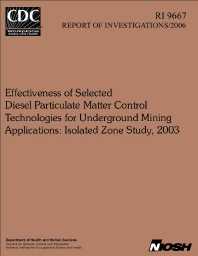Mining Publication: Effectiveness of Selected Diesel Particulate Matter Control Technologies for Underground Mining Applications: Isolated Zone Study, 2003
Original creation date: May 2006
NIOSH designed and conducted a study in an underground metal mine to assess the effects of selected diesel emissions control technologies on the concentrations of diesel particulate matter and gases in underground mine air. The control technologies studied included diesel particulate filter (DPF) systems, filtration system with disposable filter elements, diesel oxidation catalytic converter, and biodiesel blends. Each technology was tested on a mining vehicle operated in an isolated area of an underground mine supplied with fresh air. These isolated zone tests allowed for the operation of vehicles under conditions and over duty cycles that closely mimic actual duty cycles of production equipment. The DPF systems reduced the elemental carbon (EC) concentrations in mine air between 88% and 99%. The same systems reduced total particulate matter (TPM) concentrations in mine air by approximately 75%. The biodiesel blends B20 and B50 caused a reduction in the EC concentrations of 26% and 48%, respectively. Those blends also reduced TPM concentrations by 9% and 24%, respectively. The use of #1 diesel fuel reduced EC concentration by 13% compared to #2 diesel fuel. An increase in nitrogen dioxide concentration of up to two times was seen when platinum-catalyzed DPF systems were tested.
Authors: AD Bugarski, GH Schnakenberg, JD Noll, SE Mischler, LD Patts, JA Hummer, SE Vanderslice
Report of Investigations - May 2006
NIOSHTIC2 Number: 20030097
Pittsburgh, PA: U.S. Department of Health and Human Services, Public Health Service, Centers for Disease Control and Prevention, National Institute for Occupational Safety and Health, DHHS (NIOSH) Publication No. 2006-126, Report of Investigations 9667, 2006; :1-78
See Also
- Aerosols Emitted in Underground Mine Air by Diesel Engine Fueled with Biodiesel
- AQE - Air Quantity Estimator - 1.0.3
- A Computer Software Program that Estimates Air Quantity Requirements in Large Opening Stone Mines
- DEEP Project on Evaluation of Diesel Particulate Filters at Inco's Stobie Mine
- Effects of Diesel Exhaust Aftertreatment Devices on Concentrations and Size Distribution of Aerosols in Underground Mine Air
- The Effects of Water Emulsified Fuel on Diesel Particulate Matter Concentrations in Underground Mines
- Near Real Time Monitoring of Diesel Particulate Matter in Underground Mines
- Real-Time Estimation of Elemental Carbon Emitted from a Diesel Engine
- Strategies to Reduce Miners Exposure to DPM and Gases (Reno)
- Technology News 514 - The Air Quantity Estimator (AQE): A New Computer Software Tool for Large-opening Mine Ventilation Planning
- Content source: National Institute for Occupational Safety and Health, Mining Program


 ShareCompartir
ShareCompartir
